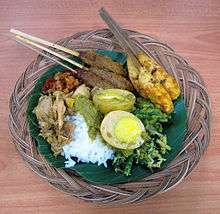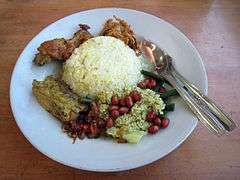Nasi campur
|
Nasi campur served at Mandarin Oriental Hotel Majapahit, Surabaya, Indonesia | |
| Alternative names | Nasi Rames |
|---|---|
| Course | Main course |
| Place of origin | Indonesia, Malaysia, Singapore, Brunei and Southern Thailand |
| Region or state | Southeast Asia |
| Serving temperature | Hot or room temperature |
| Main ingredients | Rice with various side dishes |
| Variations | Nasi Campur Bali, Nasi Rames (Indo) |
| Other information | Also popular in the Netherlands |
|
| |
Nasi campur (Indonesian/Malay: "mixed rice", also called nasi rames in Indonesia) refers to a dish of a scoop of nasi putih (white rice) accompanied by small portions of a number of other dishes, which includes meats, vegetables, peanuts, eggs and fried-shrimp krupuk.[1] Depending where it originates, a nasi campur vendor might served several side dishes, including vegetables, fish and meats.[2] It is a staple meal of the Southeast Asian countries, and popular especially in Indonesia, Malaysia, Singapore, Brunei, and southern Thailand, and also the Netherlands through its colonial ties with Indonesia. A similar form called chanpurū exists in Okinawa.
Origin and variations
Nasi campur is a ubiquitous dish around Indonesia and as diverse as the archipelago itself, with regional variations.[1] There is no exact rule, recipe or definition of what makes a nasi campur, since Indonesians and by large Southeast Asians commonly consume steamed rice surrounded with side dishes consisting of vegetables and meat. As a result, the question of origin or recipe is obscure. Yet nasi campur is commonly perceived as steamed rice surrounded with dishes that might consists of vegetables and meats, served in personal portions, in contrast to tumpeng that is served in larger collective portions or Rijsttafel that was presented in lavish colonial banquets.
There are several local variations throughout Southeast Asia: from Java, Bali, Malay Peninsular, Borneo, Sulawesi and Indo colonial to Chinese Indonesian versions of nasi campur. A similar Minangkabau counterpart is called Nasi Padang and prominent especially in Sumatra region.
Bali

In Bali the mixed rice called Nasi Campur Bali or simply Nasi Bali is a favorite among tourists.[3] This Balinese version of nasi campur probably is the most internationally well-known version, mostly due to the "Bali factor", the Balinese popularity as the island resort among international visitors.[4] The tastes are often distinctly local, punctuated by basa genep, the typical Balinese spice mix used as the base for many curry and vegetable dishes.[1] The Balinese version of mixed rice may have grilled tuna, fried tofu, cucumber, spinach, tempe, beef cubes, vegetable curry, corn, chili sauce on the bed of rice. Mixed rice is often sold by street vendors, wrapped in a banana leaf.
As a Hindu majority island, the Balinese version might add lawar and babi guling in their nasi campur fares. Nevertheless, the halal version is available, with ayam betutu, sate lilit, and eggs to accompany the rice.
Java
In Java, nasi campur is often called nasi rames, and wide variations are available across the island. One dish that usually found in a Javanese nasi campur is fried noodle. The combination known as nasi rames is a dish created in West Java during World War II by the Indo (Eurasian) cook Truus van der Capellen, who ran the Bandung soup kitchens during (and after) the Japanese occupation. Later she opened a restaurant in the Netherlands and made the dish equally popular there.
In Yogyakarta a Javanese version of nasi campur is called nasi ingkung, which consist of a whole cooked chicken dish called ayam ingkung, urapan kasultan, perkedel, empal gapit, sate tusuk jiwo and tumpeng rice.[5]
Indonesian Chinese

Some people who reside in Jakarta and other major cities with significant Chinese population area use the term nasi campur loosely to refer to Chinese Indonesian's Nasi Campur Tionghoa[6] (i.e., Chinese Style Nasi Campur), a dish of rice with an assortment of barbecued meats, such as char siew, crispy roast pork, sweet pork sausage and pork satay. This dish is usually served with simple Chinese chicken soup or sayur asin, an Indonesian clear broth of pork bones with fermented mustard greens. However, a name for a similar dish does not exist in Mainland China, Singapore, Malaysia, or even most other areas of Indonesia outside of Jakarta.
Nasi campur today
In reality the usage of the name Nasi Campur here is only for marketing and convenience purposes for the locals, and should not be included in the category of Nasi Campur. This categorization of Nasi Campur makes as much sense as categorizing all buffets with rice in them as Rijsttafel (or worse, nasi campur buffet) just because of the presence of any rice and assortment of dishes.
The name Nasi Campur Tionghoa is only a shortened version of "nasi dengan daging campur cara Tionghoa" (i.e. "rice with assortment of Chinese style meats"). Furthermore, most Chinese vendors and food-court stalls in the region serve only one kind of meat with rice and a bowl of broth; patrons have to order different meats as separate dishes or add-ons. Hence, in most cases, those Chinese vendors' menu refers to the specific meat accompanying plain rice, for example, Char Siew Rice, or Roast Pork Rice. The Nasi Campur Tionghoa in this respect, is the combo set menu of various Chinese barbecued meats.
In most cases, Nasi Campur refers specifically to the Indonesian and Malaysian versions of rice with assortments of side dishes. In Indonesia it refer to any kind of rice surrounded by various dishes. In Malaysia it refer more specifically to Malay mixed rice.[2] In Japan, United States and most of foreign countries, nasi campur often refer to the Balinese version, while in the Netherlands it is most often refer to Indo-colonial nasi rames. The side dishes itself might vary widely among regions and eating establishments.
Gallery
-

Nasi campur, Balinese version
-

Nasi campur Bali served with ayam betutu and vegetables
-
Nasi campur with buffalo soup, served in Tana Toraja, South Sulawesi
-
Nasi campur served in Jeneponto, South Sulawesi
-
Javanese nasi campur with honey chicken and tempeh
See also
References
- 1 2 3 Ashlee Betteridge (2 April 2010). "Nasi Campur: Rice With a Side of Serendipity". JakartaGlobe. Retrieved 4 July 2014.
- 1 2 "Nasi Campur (Malay Mixed Rice)". Backpacking Malaysia. Retrieved 6 July 2014.
- ↑ Wasti Atmodjo (18 March 2013). "'Nasi campur' Wardani, a tourist favorite". The Bali Daily. Retrieved 5 July 2014.
- ↑ Kosaku Yoshino. "Malaysian Cuisine: A Case of Neglected Culinary Globalization" (PDF). Sophia University Institute of Comparative Culture, Tokyo. p. 9. Retrieved May 2, 2014.
- ↑ "Royal Ambarrukmo Patenkan Nasi Campur Ambarrukmo" (in Indonesian). Harian Jogja. 8 January 2014. Retrieved 4 July 2014.
- ↑ "Nasi Campur Konghu (Chinese Mix Rice)". Jakarta the City. 6 January 2009. Retrieved 6 July 2014.
External links
-
 Media related to Nasi campur at Wikimedia Commons
Media related to Nasi campur at Wikimedia Commons
.png)